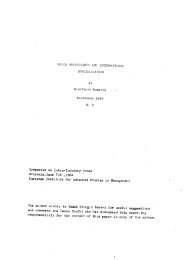BANDO DI SELEZIONE PER L'ATTRIBUZIONE DI ASSEGNI DI ...
BANDO DI SELEZIONE PER L'ATTRIBUZIONE DI ASSEGNI DI ...
BANDO DI SELEZIONE PER L'ATTRIBUZIONE DI ASSEGNI DI ...
You also want an ePaper? Increase the reach of your titles
YUMPU automatically turns print PDFs into web optimized ePapers that Google loves.
<strong>DI</strong>PARTIMENTO <strong>DI</strong> SCIENZE ECONOMICHE<br />
finding something better.<br />
All survey data that try to capture displacement are plagued to some degree by selection<br />
bias. If workers have expectations about the economic viability of their firm then those<br />
workers with good outside prospects in the labor market might quit the firm before it is<br />
closed down or before mass layoffs occur, leaving those colleagues with “worse”<br />
characteristics behind. In restructuring firms that do not close down but initiate mass<br />
layoffs, “better quality” workers might, however, remain with the firm as post-restructuring<br />
productivity gains might imply high wage growth (see e.g. Pfann (2001)). Certain workers<br />
could be encouraged to quit to save the firm redundancy payments. Whatever the selection<br />
mechanism, as long as this mechanism exists, displacement is not a purely exogenous event.<br />
Are selection problems related to mass layoffs and plant closure particularly strong in a<br />
transition economy? Potential failure or poor performance of firms might be easier to<br />
perceive in a transition economy and good workers might then be more likely to leave the<br />
firm long before closure or large-scale labor shedding than in the West. On the other hand,<br />
good workers may have more reason to hold on to their old job in restructuring firms<br />
because of higher future rewards after restructuring. Workers may also hold on to their jobs<br />
because of greater uncertainty in a rapidly changing transition labor market. This<br />
uncertainty is particularly strong in the early stages of transition. Which of these scenarios<br />
prevails in a transition economy is not clear a priori. In this project, we will allow for<br />
unobserved heterogeneity in the estimates of jobless duration and the cost of job loss. At<br />
any rate, when comparing those who quit with those who are displaced, we will keep a<br />
caveat of potential selection bias in mind.<br />
The project will also analyze directly the pecuniary costs of displacement using the method<br />
employed in Lehmann, Philips and Wadsworth (2005). In the Ukrainian case, we have<br />
information on the year and month of any job change and the duration of any intervening<br />
non-employment spell. Respondents are also asked to give gross monthly wages received at<br />
certain periods covered by the survey, typically at one-year intervals. If a worker leaves or<br />
loses a job they are asked to give their final salary. If a worker starts a new job they are<br />
asked to give their starting salary. Those who stay in their job are asked to give their wages<br />
in December of each year and this forms the basis of wage change for the “control” group,<br />
against which wage changes for displaced workers will be compared. Simply comparing<br />
wage changes before and after job loss for displaced workers does not account for any wage<br />
growth that the worker might have experienced had they remained in the job.<br />
The use of a control group of job stayers can account for this effect, (so called “differencein-difference”<br />
estimation). The displacement supplement to the RLFS will have similarly<br />
structured wage questions to ensure comparability across the two countries.<br />
One of the aim of the project will be to collect supplementary information on the predisplacement<br />
wage history of workers, which allows us to get a better handle on an<br />
“Ashenfelter wage dip” that workers might experience even before displacement takes place<br />
as reported by Jacobsen, LaLonde and Sullivan (1993) for U.S. workers. Having predisplacement<br />
wage information also enables us to use a matching variant of the “differencein<br />
difference” estimator that conditions on similar pre-displacement wage profiles of the<br />
treatment (displacement) group and the control group, thus minimizing problems arising<br />
from selection bias. While with national survey data it might be difficult to establish the<br />
“true” pre-displacement wage history of workers, the post-displacement survey data that we



